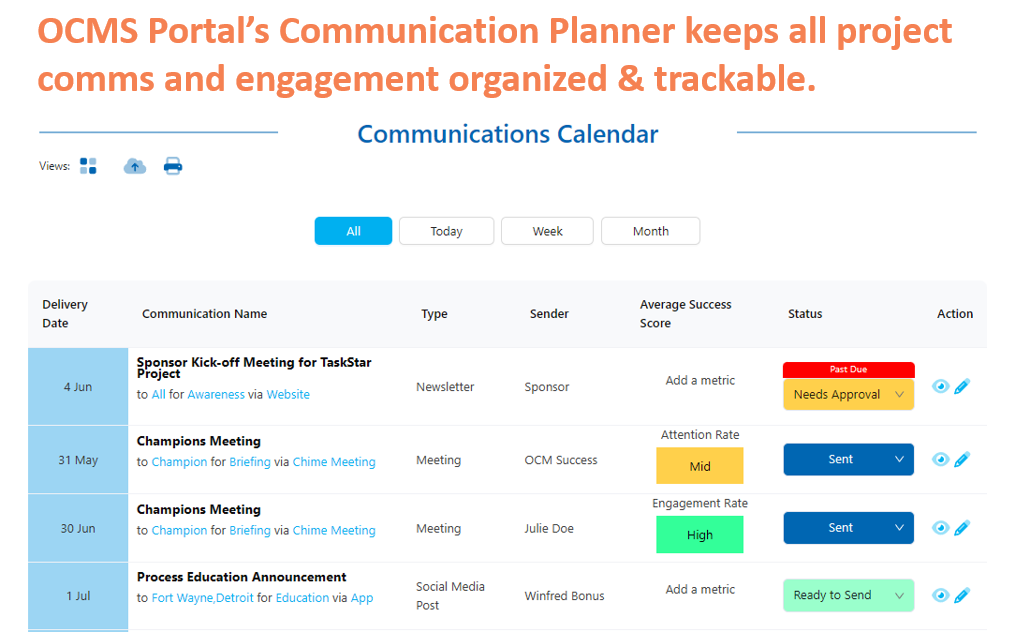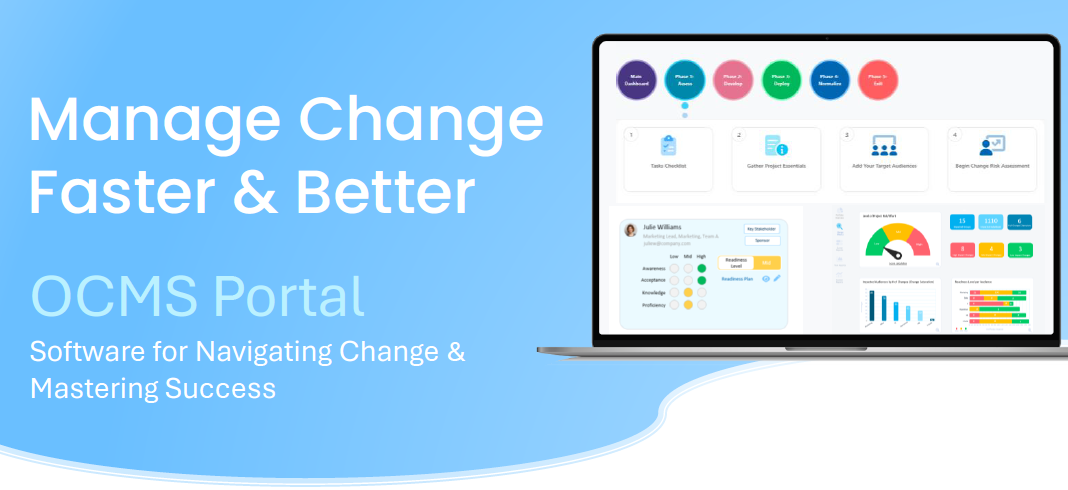Guide to OCM Stakeholder Communication Management
Imagine launching a crucial project without a well-thought-out plan for communicating with your stakeholders. The result? Chaos.
Team members are left in the dark, sponsors are frustrated by a lack of updates, and stakeholders are blindsided by unexpected issues. The project’s progress grinds to a halt as misunderstandings pile up, eroding trust and collaboration. Without a clear stakeholder communication strategy, even the most promising projects can quickly spiral into disarray, leaving everyone involved stressed and uncertain.

But it doesn’t have to be this way. In this guide, we’ll show you how to create a robust stakeholder analysis and communication plan that ensures everyone stays informed, engaged, and aligned. Drawing on best practices and proven strategies, we’ll help you craft a plan that addresses the unique needs and expectations of your stakeholders, from the initial kickoff meeting to the final project review.
By the end, you’ll have the tools to transform potential communication breakdowns into a smooth, transparent dialogue that drives your project to success. Let’s dive in and turn your project into a beacon of effective stakeholder communication and collaboration!
Story Highlights
|
Looking for a quick summary? You’ll find one next. If you’d like to dig into more detail, keep reading for a more in-depth look at stakeholder communication management.
Quick Summary
Understanding the Importance of Stakeholder Communication
Effective communication with stakeholders during a change initiative is the lifeblood of any successful project. Stakeholders—whether they are team members, clients, sponsors, or external partners—hold varying degrees of influence and interest in the project. Their support, feedback, and involvement can significantly impact your project’s trajectory. Thus, understanding their needs, expectations, and concerns is essential for fostering a collaborative and productive project environment.
Without a solid stakeholder analysis and communication plan, you risk alienating these key players. Misunderstandings can arise, leading to misaligned goals and objectives. For instance, if a sponsor is not regularly updated on project progress, they may become anxious and start to question the project’s viability.
Similarly, if team members are unaware of changes in project scope or timelines, their productivity and morale can suffer. A structured stakeholder PMO communication plan acts as a roadmap, guiding how and when to share information, address issues, and engage stakeholders. This proactive approach not only mitigates risks but also builds trust and transparency, ensuring that all parties remain committed and informed throughout the project lifecycle.
Do you have any questions about a stakeholder mapping communication plan or the project communications management process? Please reach out and let us know!
Starting Your Stakeholder Communication Plan: A Multi-Pronged Approach
Embarking on the journey to create an effective stakeholder mapping communication plan begins with understanding that different stakeholders have diverse preferences and needs. A one-size-fits-all approach will not suffice. To ensure comprehensive and effective communication, it’s vital to adopt a multi-pronged strategy that utilizes various delivery channels tailored to each stakeholder group.
Identify Stakeholder Preferences and Needs
The first step is to conduct a thorough stakeholder analysis. Identify who your stakeholders are, what their interests and expectations entail, and how they prefer to receive information. Some stakeholders might appreciate detailed reports and in-depth meetings, while others might favor quick updates via email or instant messaging. Surveys or direct conversations can be invaluable in uncovering these preferences.
Utilize Diverse Communication Channels
Once you have a clear understanding of your stakeholders’ needs, it’s time to leverage a mix of communication channels. Here are some key methods to consider:
- Email Updates: Ideal for providing regular, detailed updates that stakeholders can read at their convenience. Emails can include progress reports, meeting summaries, and important announcements.
- Meetings and Workshops: These are essential for in-depth discussions, brainstorming sessions, and resolving complex issues. They offer a platform for direct interaction and immediate feedback.
- Instant Messaging and Collaboration Tools: Platforms like Slack or Microsoft Teams facilitate quick, real-time communication, making it easier to address urgent questions and foster ongoing collaboration.
- Project Management Software: Tools like Trello, Asana, or Jira provide a centralized hub where stakeholders can track project progress, milestones, and deadlines. This transparency helps in keeping everyone aligned and informed.
- Newsletters and Reports: Regular newsletters or comprehensive reports can keep stakeholders updated on the broader progress and key achievements of the project, providing a snapshot of where things stand.
Tailor the Message
Equally important is tailoring the message to suit the audience. Senior executives might be interested in high-level overviews and strategic insights, while team members may need more detailed, operational information designed to help them adopt changes successfully. Customizing the content in your stakeholder analysis and communication plan ensures that each stakeholder receives relevant and actionable information, enhancing their engagement and support.
By adopting a multi-pronged approach and utilizing a variety of communication channels, you can ensure that your stakeholder communication plan is robust, inclusive, and effective. This strategic diversity not only caters to the varied preferences of your stakeholders but also fosters a more dynamic and responsive project environment.
Businesses with robust internal communications see better project results than those without them, and many employees blame failures on poor communication.
Stakeholder Engagement by Change Management Phase
Effective stakeholder communication is crucial during each phase of change management. Tailoring your approach to fit the unique needs and dynamics of each stage ensures stakeholders are informed, engaged, and supportive throughout the transition. Here’s how to plan your communications across the five key phases: Assess, Develop, Deploy, Normalize, and Exit.
Phase 1: Assess
During the Assess phase, the primary goal for your PMO communication plan is to understand the current state, identify key stakeholders, and gauge their readiness for change. Communication efforts should focus on transparency and information gathering.
- Kickoff Meetings: Host initial meetings with stakeholders to explain the purpose of the assessment and what it entails. Clearly outline the objectives and expected outcomes.
- Surveys and Interviews: Use surveys and one-on-one interviews to collect input from stakeholders about current challenges and their perspectives on potential changes.
- Regular Updates: Provide periodic updates through emails or newsletters to keep stakeholders informed about the assessment’s progress and preliminary findings.
Phase 2: Develop
In the Develop phase, the focus of your stakeholder analysis and communication plan shifts to planning and designing the change. This stage requires collaborative communication to ensure all stakeholders are on the same page.
- Workshops and Focus Groups: Conduct workshops and focus groups to involve stakeholders in developing the change strategy and plans. This participatory approach helps in garnering their buy-in.
- Detailed Reports and Proposals: Share comprehensive reports and proposals outlining the planned changes, including timelines, expected benefits, and potential impacts.
- Feedback Mechanisms: Establish clear channels for stakeholders to provide feedback on the proposed changes, such as suggestion boxes or dedicated email addresses.

Phase 3: Deploy
The Deploy phase is where the change is implemented. Stakeholder communication should be frequent and clear to guide stakeholders through the transition.
- Implementation Announcements: Send out detailed announcements about the upcoming changes, including what will happen, when, and how it will affect stakeholders.
- Training Sessions: Organize training sessions and workshops to ensure stakeholders are well-prepared to adapt to the changes.
- Real-time Updates: Utilize instant messaging and project management tools to provide real-time updates on the deployment process and address any immediate concerns or issues.
Phase 4: Normalize
In the Normalize phase, the goal is to ensure the changes are integrated smoothly into regular operations. The project management stakeholder communication plan should focus on monitoring and reinforcing the change.
- Progress Reports: Share regular progress reports highlighting how well the changes are being integrated and any adjustments made to optimize the process.
- Recognition and Rewards: Communicate successes and recognize stakeholders who have adapted well to the changes, reinforcing positive behavior.
- Feedback Loops: Continue to solicit feedback on the change’s impact and any additional support needed to fully embed the new processes.
Phase 5: Exit
The Exit phase involves wrapping up the change management process and transitioning to a steady-state environment. Here, the stakeholder communication strategy should focus on closure and reflection.
- Final Reports and Reviews: Distribute final reports summarizing the entire change process, key achievements, lessons learned, and any outstanding issues.
- Thank You Messages: Send thank-you messages to all stakeholders, acknowledging their efforts and contributions throughout the change process.
- Post-Implementation Review Meetings: Conduct meetings to review the overall success of the change, discuss what went well, and identify areas for future improvement.
By meticulously planning your stakeholder communications for each phase of change management, you ensure a smooth transition, foster trust, and maintain high levels of engagement and support from all stakeholders involved.
Get Free Communication and Stakeholder Engagement Plan Templates!
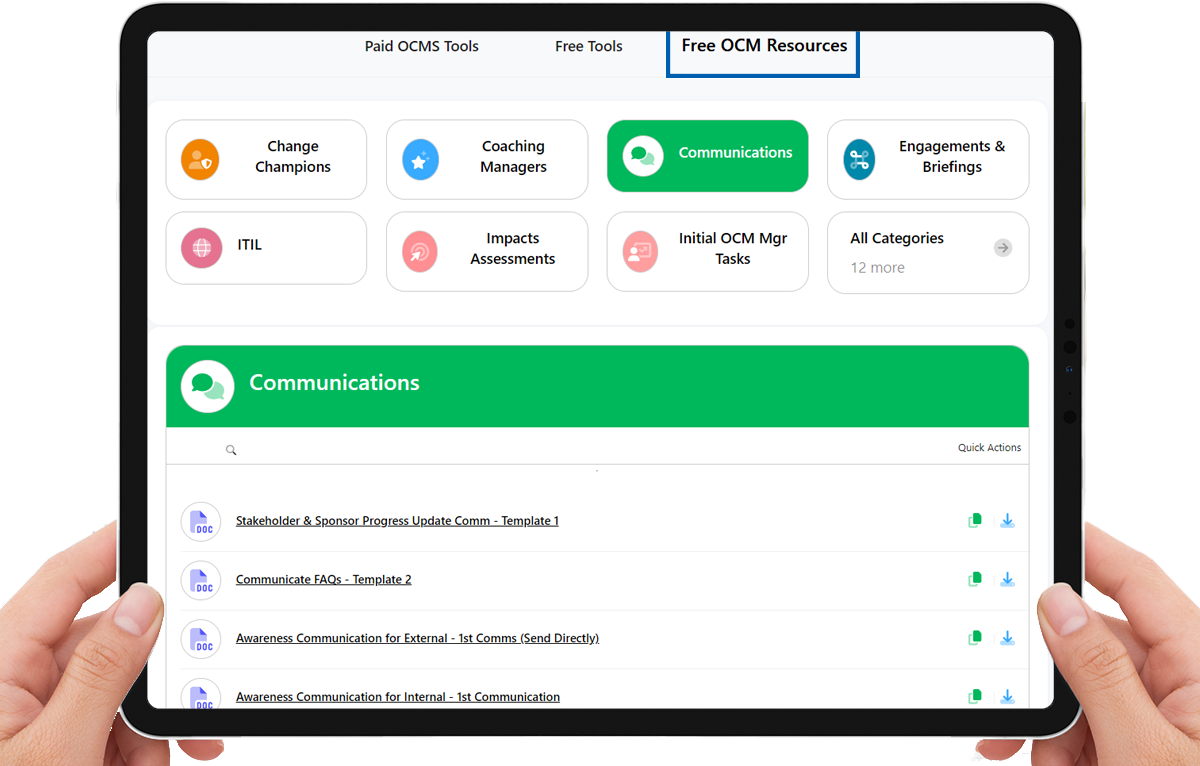
Summary Conclusion | Stakeholder Communication Strategy
Are you ready to take your stakeholder communication plan to the next level? By implementing the strategies and utilizing the templates provided in this guide, you can build stronger relationships, garner increased support, and navigate challenges more effectively. Remember, communication is an ongoing process. Stay engaged with your stakeholders, adapt your approach as needed, and keep these valuable connections thriving.
Looking for a deeper dive into the project communications management process? Keep reading for a detailed, step-by-step guide to building a project management stakeholder communication plan.
Detailed Deep Dive
Implementing a Communication and Stakeholder Management Plan
Published for Change Management Practitioners, Project Managers, and Program Leads, this free guide provides you with everything you need to know about the best stakeholder communication plan for engaging with key stakeholders in a project. It includes details on stakeholder communication strategy examples, samples, templates, and change tools that you can use for your needs.
During project implementation, a lack of communication can result in failure. If the stakeholders being impacted by a change aren’t properly informed and engaged, there’s a low chance that they’ll be able to successfully adopt the culture, process, tool, etc. required by the project.
In this guide for a stakeholder management communication plan, we’ll define what this plan should look like and why it’s important. We’ll also go through a step-by-step communication and stakeholder engagement plan template that you can use as a reference for your own projects.
See Also: Software for managing OCM and stakeholder communications
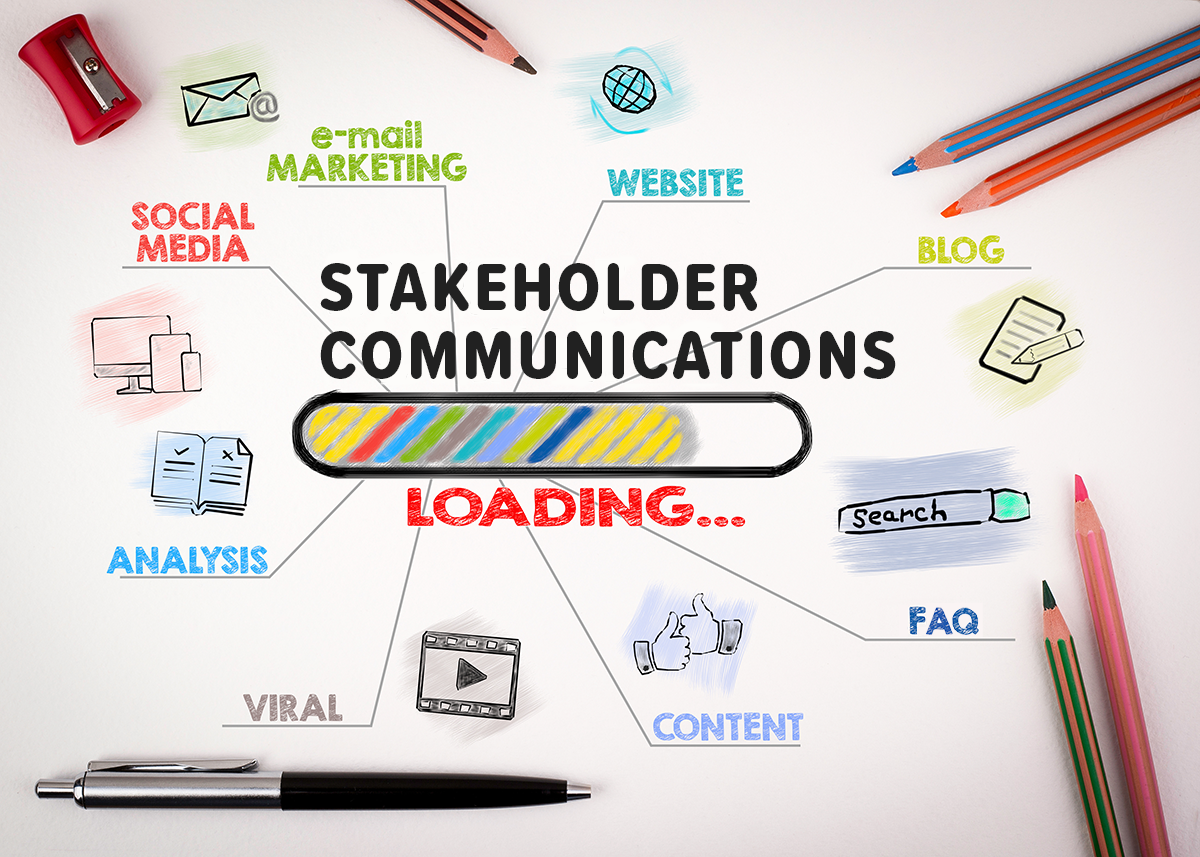
Guide to a Stakeholder Engagement Strategy and Communications Plan
The sections below provide you with the detailed steps to carry out a stakeholder communication strategy, approach and implementation for your project.
Table of Contents – Stakeholder Communication Strategy
Keep on scrolling down this page to read each section or click any link below to go directly to that section.
1. What Is a Stakeholder Communication Plan?
2. Why Is a Project Communications Management Process Important?
3. What Is the Best Way to Communicate with Stakeholders?
4. Overview: Developing a Stakeholder Engagement Communication Plan
a. Identify Groups Being Impacted by a Project
b. Identify Key Stakeholders in the Impacted Groups
c. Determine the Types of Communications Needed
d. Develop Your Key Project Messaging
e. Create Your Stakeholder and Communication Plan Schedule
f. Have Communications Drafted & Reviewed
g. Deploy Your Communication and Stakeholder Engagement Strategy
h. Track Stakeholder Communication Strategy Metrics & Enhance Your Plan
5. Conclusion
See Also: Software for managing stakeholder engagement and end-to-end OCM
Do you have any questions about effective project communications management process for stakeholders or stakeholder engagement and communication plan templates? Please reach out and let us know.
What Is a Stakeholder Communication Plan?
Your stakeholder management communication will be done throughout a project that is impacting stakeholders in an organization. It’s the strategy you put together to ensure everyone knows what they need to know when they need to know it.
For example, a communication and stakeholder management plan would include making everyone that needs to know aware of an upcoming change that is impacting their day-to-day activities.
You would typically call this type of introduction to a change, an “awareness communication.”
It’s important to tell people BEFORE they need to adopt a new process, procedure, tool, or other change. Otherwise, they won’t be properly prepared or ready to do what’s needed of them when the project is “live” (i.e., deployed in the organization).
A stakeholder communication strategy example would include things like:
- The type of communication (awareness, scheduling, training, survey, etc.)
- The audience for the communication (organizational group or external)
- How the communication is being given (email, messaging, meeting, etc.)
- What the communication is
- Who is responsible for delivering the communication
- Important dates, (start date, end date, and sent date)
Your stakeholder management and communication plan will include all the things you need to make people aware of and a schedule for providing those communications.

Is there a best stakeholder engagement communication plan Excel or online template that you have used that you would like to share with other project managers and change leads? Please, reach out and let us know.
Why Is a Project Communications Management Process Important?
Why can’t you just have one meeting to tell people about a project that’s impacting them and leave it at that? If you want any communication to be successful, you need to reinforce it in multiple ways and several times. It also should be personalized for the activity and group.
Trying to capture all the things that need to be communicated during stakeholder engagement and communication for a project in just one or two meetings isn’t going to ensure your message sticks.
People tend to tune out and forget information when they have too much incoming at one time. Your stakeholder communication management should include a variety of different communication types as well as give stakeholders “bite-sized pieces” of information when they need it.
What type of a difference does a good stakeholder management communication plan make? Here are a few statistics:
- Businesses with effective internal communications see 3.5x better results
- 86% of employees blame company failures on poor communication
- Well-informed employees outperform their peers by 77%
Often, the success of project implementation will depend upon how effective the stakeholder engagement communication is before, during, and after the project solution is deployed.
Please let us know if you’ve been looking for a stakeholder communication plan example or communication and stakeholder engagement plan template. We’ll be happy to help!
What Is the Best Way to Communicate with Stakeholders?
The best way to communicate when putting together a stakeholder management communication plan template is… many different ways!
Some people are visual learners, some prefer information in short snippets of text, others may remember it better with a face-to-face meeting or video.
You should include a multi-prong strategy when developing your communication and stakeholder management plan. You want to ensure that you are using different channels of delivery for your various types of communications.
A stakeholder communication plan example of online communication delivery channels would be:
- Social media posts
- Internal messaging app (like MS Teams or Slack)
- Internal team site
- Company blog
- Virtual meeting
- Pre-recorded on-demand videos
An example of offline communication delivery channels for a stakeholder engagement strategy and communications plan would be:
- In-person meetings
- Team workshops
- Postcard mailers
- Corporate events
We recommend using at least four different delivery channels when planning your overall stakeholder communication strategy.
If you have any questions about using the stakeholder assessment guide and stakeholder communication plan outlined in this guide, reach out to let us know. Your stakeholder and communication plan are critical to users’ adoption of the changes the project requires.
Illustration: Stakeholder Communication Plan Example Dashboard
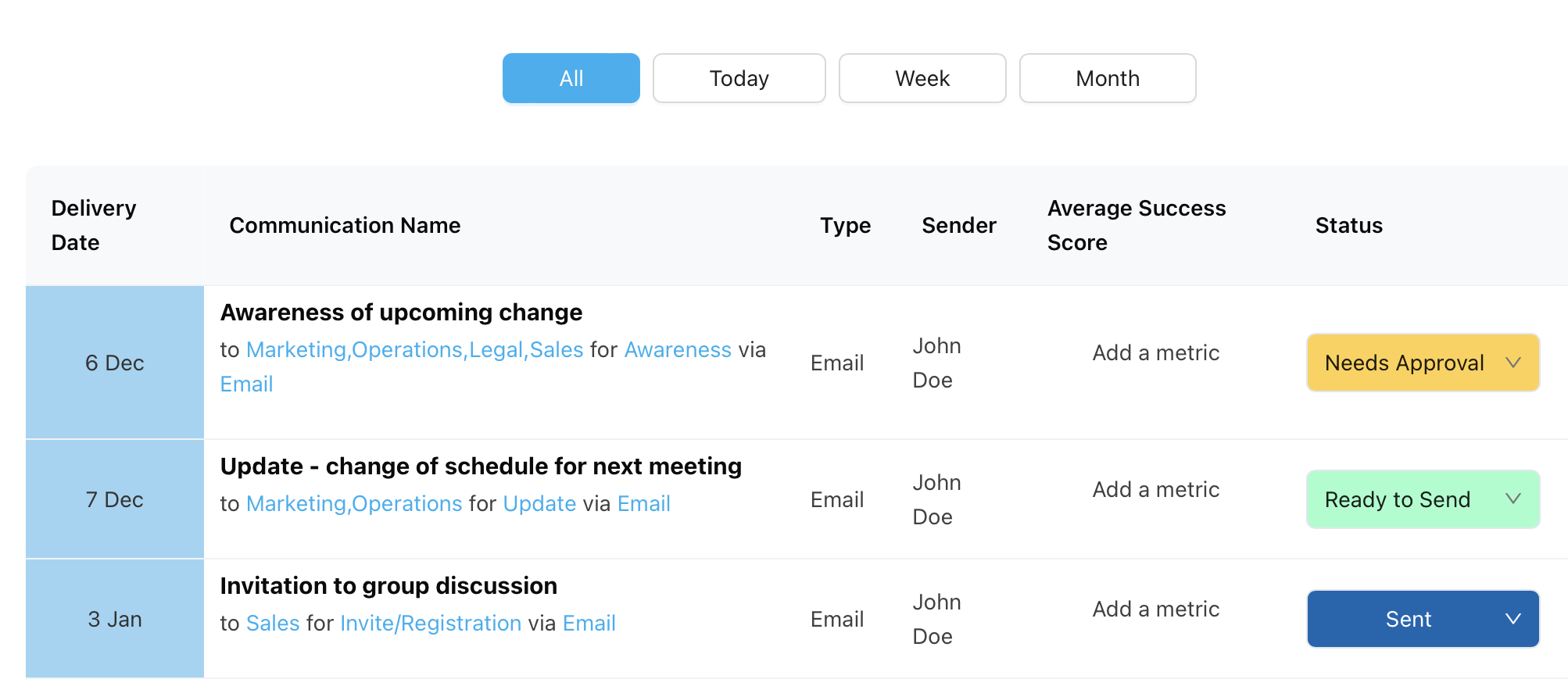
OCMS Portal’s Stakeholder Communication Management Tool for Your Stakeholder Strategy
Using stakeholder engagement and communication tools is essential to understanding who you need to communicate with, when you need to communicate with them, and what you need to communicate to them.
Overview: Developing a Stakeholder Engagement Communication Plan
The project communications management process begins when you are doing some of your other analyses. Namely, the change impacts assessment and the stakeholder analysis. These are included in the first two steps below.
Following is an overview of the steps you’ll take to complete a stakeholder communication plan:
1. Identify Groups Being Impacted by a Project
2. Identify Key Stakeholders in the Impacted Groups
3. Determine the Types of Communications Needed
4. Develop Your Key Project Messaging
5. Create Your Stakeholder and Communication Plan Schedule
6. Have Communications Drafted & Reviewed
7. Deploy Your Communication and Stakeholder Engagement Strategy
8. Track Stakeholder Communication Strategy Metrics & Enhance Your Plan
Are there stakeholder communication plan examples that you would like to share with other project managers and change leads? Please, reach out and let us know.
Stakeholder Communication Plan Example (Step-by-Step)
1. Identify Groups Being Impacted by a Project
During the change impact assessment, the groups being impacted by a project will be identified. These are the groups from which stakeholders will be determined. Those stakeholders will be targeted in your communication and stakeholder engagement plan.
2. Identify Key Stakeholders in the Impacted Groups
Your communication and stakeholder engagement plan template will need to include the key stakeholders. These would be the key managers, sponsors, leadership, or role representatives of an impacted group.
First, you should identify whether the group is internal or external.
Internal Stakeholders
Internal stakeholders are individuals and groups that are part of the company’s organizational structure and that are being impacted by the change.
External Stakeholders
External stakeholders are groups and individuals that are NOT part of the company’s organizational structure (e.g., customers, suppliers).

Illustration: Stakeholder Communication Plan – Stakeholder Communication Reports
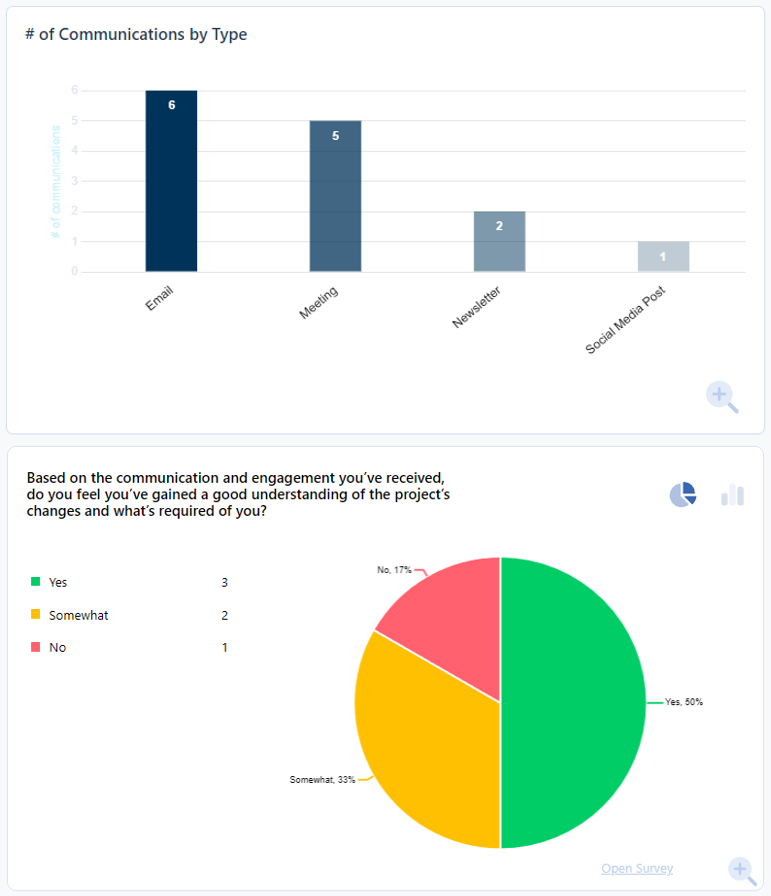
OCMS Portal makes it easy to plan and assess stakeholder engagement communication with intelligent reporting.
Next, you’ll want to decide on your stakeholder types or categories. This will help you when populating your stakeholder management communication plan template because you’ll be able to sort and search according to each type of stakeholder.
Some of the main types of stakeholders to consider in your stakeholder communication plan are:
- Primary stakeholders
- Project sponsors
- Key Stakeholders
- Critical stakeholder
- Influencer
- Change Agent/Champion
- Impacted End-User
3. Determine the Types of Communications Needed
The scope and needs of the project will determine the different types of communications needed. There also may be different communications needed for different stakeholder types.
Some of the typical types of communications you’ll see in a stakeholder engagement strategy and communications plan will be:
- Awareness
- Scheduling
- Training
- Educational
- Leadership Updates
- Surveys
- And more
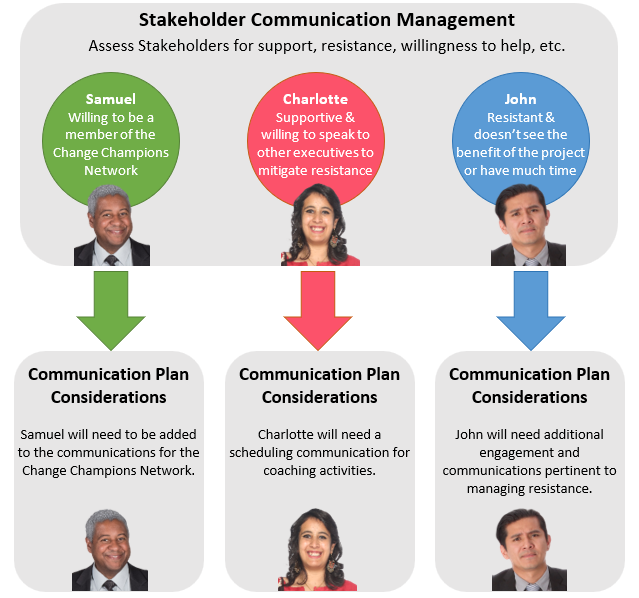
See also: OCMS Portal stakeholder communication plan example, samples & tools.
Get your free trial of OCMS Portal, with Stakeholder Mapping Tool, and start conducting your stakeholder management planning and analysis today.
4. Develop Your Key Project Messaging
Next, you’ll want to develop the overarching messages for your stakeholder communication strategy. This would include things like the main benefits of the project for the impacted stakeholders, and key project goals and vision.
While each communication will differ according to the objective, you want all messaging across your stakeholder communication plan to have a consistent theme and to repeat the same overarching concepts. Repetition fosters better message understanding and retention.
5. Create Your Stakeholder and Communication Plan Schedule
For this step, you’ll take all the information gathered in Steps 1-4 and develop your list of communications that need to go out to your stakeholders and your timeline of when they will need to go out.
It’s very helpful to have a stakeholder engagement and communication plan template to input all this information. Especially one like the OCMS Portal end-to-end change management software that will generate a comprehensive communications delivery schedule.
Illustration: Stakeholder Communication Plan Example Report
Use OCMS Portal to assess & manage stakeholders and plan your communications for the stakeholder project communications management process.
6. Have Communications Drafted & Reviewed
Now that you have your communication and stakeholder management schedule in place, you’ll be ready to have the communications drafted and reviewed.
Don’t Miss: Best communication and stakeholder management guide, plan, and practices. Also, contact us if you have any questions or feedback about this stakeholder engagement strategy and communications plan tutorial.
7. Deploy Your Communication and Stakeholder Engagement Strategy
Now, you’ll send out your communications according to your stakeholder communication plan. You’ll want to keep track of when each communication goes out and what stage communications are in (being drafted, need approval, etc.).
Using a software template to manage your stakeholder communication strategy ensures that nothing gets missed, you have a place to track communication success, and can report easily on your activities to others.
Illustration: Stakeholder Communication Plan Example Template
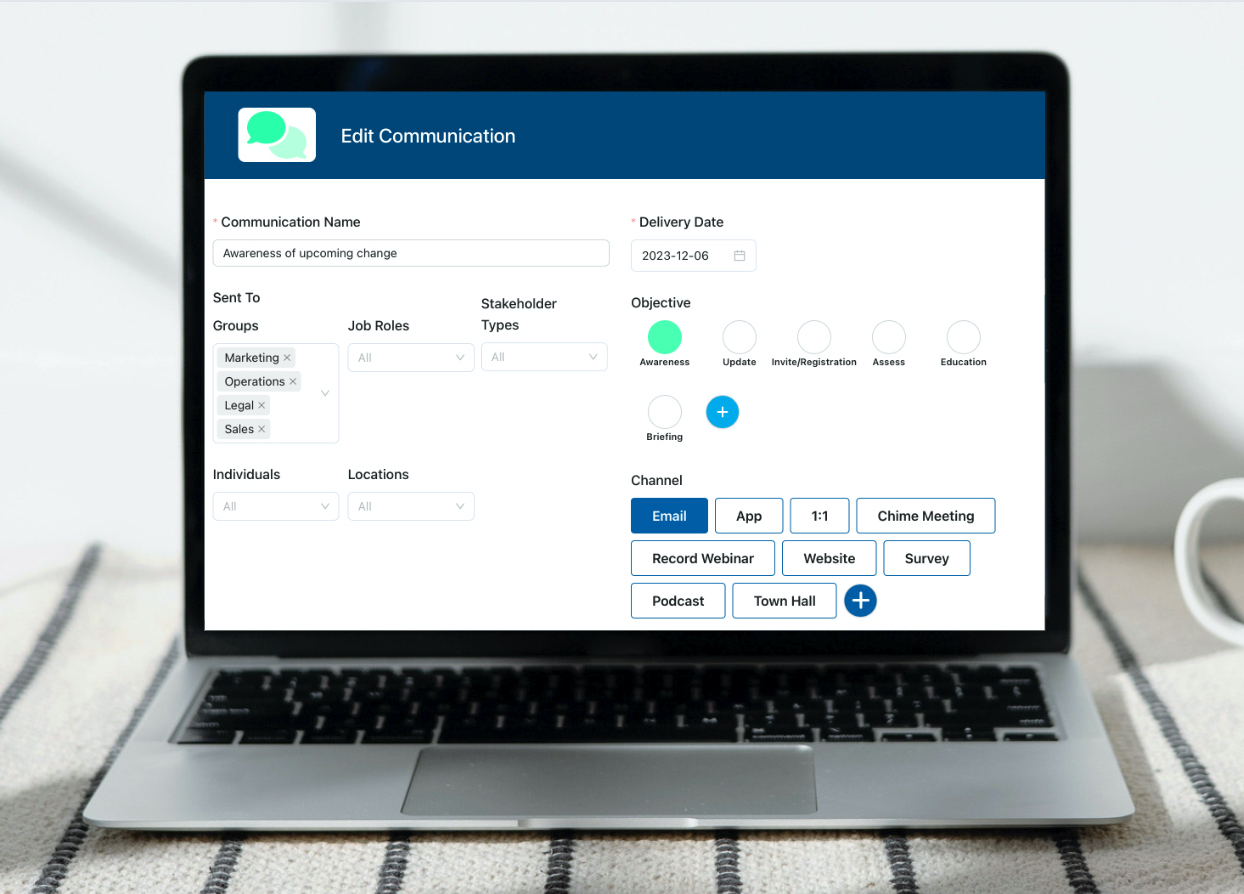
OCMS Portal Project Communications Management Process Template
Do you have any questions or feedback about this OCM Solution guide? Please reach out and let us know.
8. Track Stakeholder Communication Strategy Metrics & Enhance Your Plan
It’s important to track the metrics and KPIs for your stakeholder communication plan. This would include things like user engagement, delivery success, and whether recipients are taking the desired actions that the communication was intended to drive.
Analyze the metrics as part of your ongoing project communications management process and continually enhance your plan based on what you see.
Conclusion – OCM Solution Stakeholder and Communication Plan Guide
We hope this end-to-end stakeholder communication plan has helped in answering the key questions you might have had regarding how to implement an engagement and communication plan for stakeholders being impacted by a change.
Do you have a stakeholder communication plan example that you would like included in this guide? Contact us and let us know.
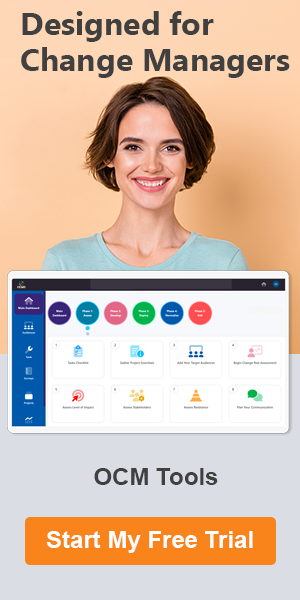
Stakeholder Management Communication Plan Template
Streamline your stakeholder analysis and communications plan with help from our state-of-the-art software. It includes a timesaving stakeholder communication management tool with scheduling, reporting, and more!
OCMS Portal is an all-in-one change management platform. It provides detailed and high-level analytics of your stakeholder communication and engagement activities. It also provides a structured step-by-step process that’s easy for new change practitioners to follow.
See it in Action… Sign up for a free trial now.
The OCMS Portal gives you one place to handle all your communication and stakeholder management activities!
Stakeholder Communication Plan Example FAQ
The stakeholder communication plan is the strategy you put together to ensure everyone knows what they need to know when being impacted by change.
Often, the success of project implementation will depend upon how effective the stakeholder engagement communication is before, during, and after the project solution is deployed. People need to be prepared and communicated with about upcoming changes for them to learn what is needed to adopt them.
There is no single best way to communicate with stakeholders. The key is to use several different communication channels. We recommend using at least four different delivery channels when planning your overall stakeholder communication strategy.
A stakeholder communication strategy example would include things like: External Sources: https://stock.adobe.com, https://www.ls.graphics/free/free-pixel-4-and-pixelbook-go-mockup, Microsoft 365 Clip Art Image(s) (Bing images licensed under the Creative Commons license system.)What is a stakeholder communication plan?
Why is a project communications management process important?
What is the best way to communicate with stakeholders?
What should be included in a stakeholder communication plan?
• Type of communication (awareness, scheduling, training, survey, etc.)
• The communication audience description
• How the communication is being given
• What the communication is
• Who is responsible for delivering the communication
• Important dates (start date, end date, sent date)
Note: Content on OCM Solution's ocmsolution.com website is protected by copyright. Should you have any questions or comments regarding this OCM Solutions page, please reach out to Ogbe Airiodion (Change Management Lead) or the OCM Solutions Team today. OCM Solution was previously known as Airiodion Global Services (AGS).




